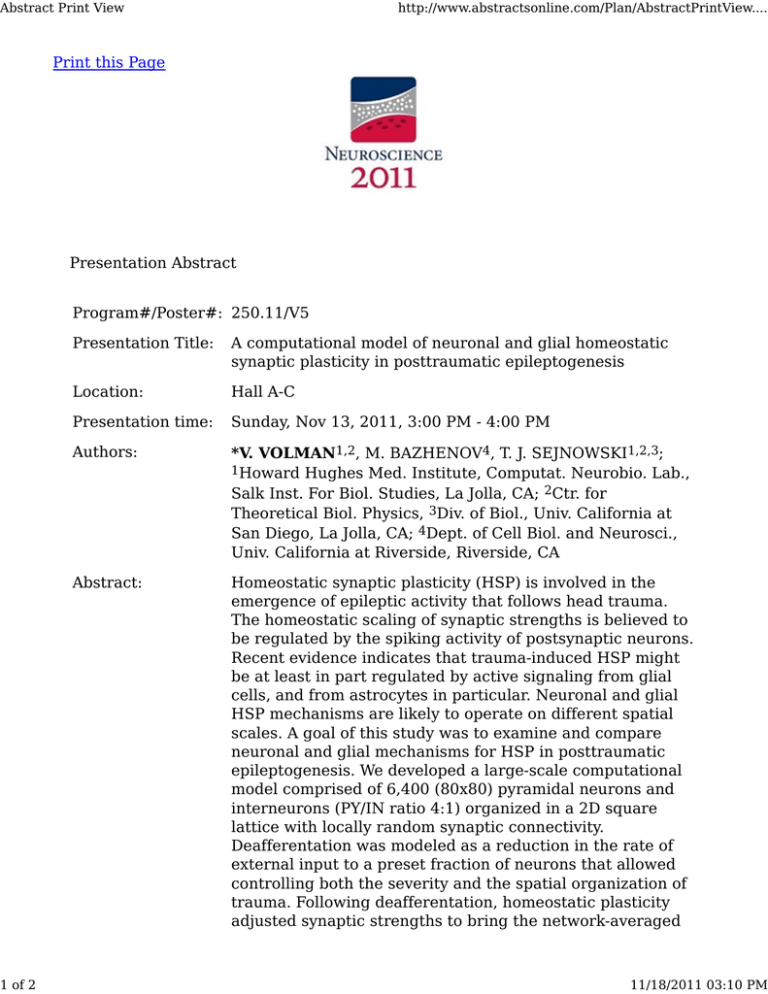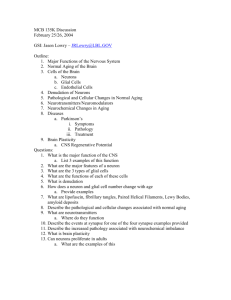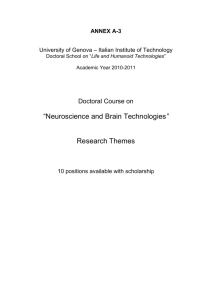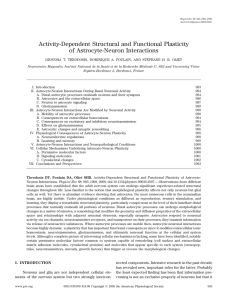
Abstract Print View
1 of 2
http://www.abstractsonline.com/Plan/AbstractPrintView....
Print this Page
Presentation Abstract
Program#/Poster#: 250.11/V5
Presentation Title:
A computational model of neuronal and glial homeostatic
synaptic plasticity in posttraumatic epileptogenesis
Location:
Hall A-C
Presentation time:
Sunday, Nov 13, 2011, 3:00 PM - 4:00 PM
Authors:
*V. VOLMAN1,2, M. BAZHENOV4, T. J. SEJNOWSKI1,2,3;
1Howard Hughes Med. Institute, Computat. Neurobio. Lab.,
Salk Inst. For Biol. Studies, La Jolla, CA; 2Ctr. for
Theoretical Biol. Physics, 3Div. of Biol., Univ. California at
San Diego, La Jolla, CA; 4Dept. of Cell Biol. and Neurosci.,
Univ. California at Riverside, Riverside, CA
Abstract:
Homeostatic synaptic plasticity (HSP) is involved in the
emergence of epileptic activity that follows head trauma.
The homeostatic scaling of synaptic strengths is believed to
be regulated by the spiking activity of postsynaptic neurons.
Recent evidence indicates that trauma-induced HSP might
be at least in part regulated by active signaling from glial
cells, and from astrocytes in particular. Neuronal and glial
HSP mechanisms are likely to operate on different spatial
scales. A goal of this study was to examine and compare
neuronal and glial mechanisms for HSP in posttraumatic
epileptogenesis. We developed a large-scale computational
model comprised of 6,400 (80x80) pyramidal neurons and
interneurons (PY/IN ratio 4:1) organized in a 2D square
lattice with locally random synaptic connectivity.
Deafferentation was modeled as a reduction in the rate of
external input to a preset fraction of neurons that allowed
controlling both the severity and the spatial organization of
trauma. Following deafferentation, homeostatic plasticity
adjusted synaptic strengths to bring the network-averaged
11/18/2011 03:10 PM
Abstract Print View
2 of 2
http://www.abstractsonline.com/Plan/AbstractPrintView....
firing rate to the target value of 5 Hz. Both neuronal
(through synaptic scaling based on postsynaptic activity)
and glial (through synaptic scaling based on presynaptic
activity) HSP mechanisms were incorporated in the model.
Paroxysmal activity appeared in the network when the
fraction of lesioned neurons exceeded some critical value.
Bursts were generated at the boundary between intact and
deafferented tissue and propagated into the latter. In the
absence of the neuronal HSP mechanism, the dependence
of the rate of paroxysmal activity on the trauma volume
could be modulated by varying the spatial scale of glial HSP
mechanism. In the presence of neuronal HSP mechanism,
the rate of paroxysmal activity was high and nearly
independent of the trauma volume. When the
experimentally observed morphological changes of
astrocytes in the traumatized tissue were included in the
model, there was a reduced rate of paroxysmal discharges
even in the presence of neuronal HSP. This study shows that
neuronal and glial mechanisms of homeostatic plasticity
might have complementary roles in posttraumatic
epileptogenesis. The model suggests that morphological
remodeling of astrocytes (experimentally observed
immediately after trauma event) might be a protective
mechanism aimed to reduce the incidence of paroxysmal
discharges caused by HSP.
Disclosures:
V. Volman: None. M. Bazhenov: None. T.J. Sejnowski:
None.
Keyword(s):
BRAIN INJURY
SYNAPTIC PLASTICITY
EPILEPTIFORM
Support:
NIH Grant R01 NS059740
NSF Grant PHY-0822283
[Authors]. [Abstract Title]. Program No. XXX.XX. 2011
Neuroscience Meeting Planner. Washington, DC: Society for
Neuroscience, 2011. Online.
2011 Copyright by the Society for Neuroscience all rights
reserved. Permission to republish any abstract or part of
any abstract in any form must be obtained in writing by SfN
office prior to publication.
11/18/2011 03:10 PM







